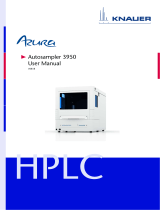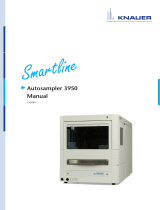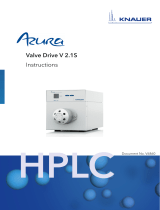Page is loading ...

ver.20221202E
Resonac Corporation (https://www.shodex.com/)
1
Operation Manual
Shodex CLNpak EV-2000 AC
(Please read this operation manual carefully to achieve the best and consistent column performance for a long time.)
Important Handling Instructions
Caution! · Please consult the Safety Data Sheet (SDS) of reagents and solvents used with the column
and understand their proper handling methods to prevent potential health hazards or death
from occurring.
· Please wear appropriate personal protective equipment such as lab goggles and gloves
when handling organic solvents and acid and alkaline reagents. Avoid any direct physical
contact to prevent chemical injuries.
Before Using the Column
(1) Please visually inspect the column package and the column surface for any damage.
(2) Please check the product name and serial number (Serial no. or S/N) written on the column package and
adhesive label on the column body.
(3) Please download the Certificate of Analysis (CoA) for the purchased product. The CoA can be downloaded
from Shodex website (https://www.shodex.com/download/). You will be asked to enter the serial number.
1. Introduction
Thank you for purchasing the Shodex product. Shodex CLNpak EV series is GPC clean-up columns packed
with styrene divinylbenzene copolymers. It is suitable for clean-up of residual pesticide components in foods.
2. Column Components
Please refer to the Shodex website: https://www.shodex.com/en/da/07.html
3. Column Specifications
Product
Code Product Name
Column Size (mm) Particle Size
(μm)
Theoretical Plate
Number
(Per Column)
I.D. Length
F6090003 CLNpak EV-2000 AC 20.0 300 16 ≥ 4,000
F6090004
CLNpak EV-G AC
20.0 100 16 (Guard Column)
Base Material
: Spherical porous particles of styrene divinylbenzene copolymer
Column Housing
: SUS-316
Screw Type
: Internally-threaded type No.10-32 UNF
Shipping Solvent
: Acetone/Cyclohexane = 3/7
4. Usable Conditions
Usable solvents are listed below.
(1) The standard eluent is a mixture of acetone and cyclohexane.
Recommended acetone to cyclohexane ratio is between 2:8 and 3:7.
(2) Up to 100 % (v/v) acetone, ethyl acetate, cyclohexane, toluene, and dichloromethane are usable.
Product Name Recommended Flow Rate
(mL/min)
Maximum Pressure
(MPa/column)
Recommended
Temperature (°C)
CLNpak EV-2000 AC 4 - 5 2.5 40
CLNpak EV-G AC
- -

ver.20221202E
Resonac Corporation (https://www.shodex.com/)
2
Attention! · Use the column within above stated flow rate, pressure, and temperature ranges. Using
the column outside the given range may damage the column and lower its performance.
· Column pressure is influenced by the eluent composition, flow rate, and column
temperature. When changing the eluent compositions, adjust the flow rate and column
temperature so that the column pressure remains below the usable maximum pressure.
· Fast flow rate settings prevents the eluent that going through the column to reach the set
column oven temperature. It is recommend to equip a “coiled SUS tubing” inside the
column oven to help the situation. It should be placed in-between the injector and the
column. A 0.5 mm I.D. x 10 - 20 m SUS tubing is recommended for making the coil.
5. Eluent Preparation
(1) Degas the eluent fully to prevent the formation of air bubbles.
(2) Presence of small debris or insoluble substances may result in deterioration of columns and/or they may
appear as noise on chromatograms. Filter the eluent with a 0.45-μm disposable filter to prevent the problems
from occurring.
Attention! · Use of HPLC grade organic solvents of guaranteed quality, which can be used without
problems in HPLC is recommended. If organic solvents with different grades are used
together, make sure that their qualities are all suitable for the analysis prior to the use.
Solvents left in opened bottles for a long time should not be used. The content may have
been changed, absorbed moisture, or has been contaminated.
· Always use freshly prepared solvents. Solvents stored for a long time may have changed
their compositions and may influence elution patterns and/or damage the column.
Note · Use of an on-line degasser is recommended.
6. Sample Preparation
(1) If possible, use the eluent for analysis to dissolve or dilute samples. If this is difficult, use a solvent which
has a composition that is as close as possible to the eluent composition and which fully dissolves or dilutes
the sample. For gradient elution, samples are recommended to be dissolved or diluted using the eluent used
at the beginning of the gradient method.
(2) Filter diluted sample solutions using disposable 0.45-μm filters to prevent the column from clogging or
deteriorating.
(3) Suggested injection volume is less than 5 mL.
(4) Samples with large amount of lipids have high viscosities. This delays the elution of lipids and interferes its
separation from pesticides. Another potential problem of highly viscous samples is that a portion of sample
may be retained in the injector and not fully injected. Thus, dilution of such samples with the eluent is
recommended. Suggested maximum lipid load per injection is less than 500 mg.
Attention! · When a sample is dissolved in a solvent other than the eluent and if the sample matrix
contains components which do not dissolve in the eluent fully, precipitates may form and
clog the column.
Note · Use of a guard column is recommended to protect the analytical column.

ver.20221202E
Resonac Corporation (https://www.shodex.com/)
3
7. Column Usage Procedure
7.1 HPLC System Preparation
Wash the entire HPLC system prior to column installation, including all flow-lines and sample loop by switching
the valves, and then replace the washing solution with the eluent to be used. If desired new eluent has low
miscibility/solubility to the eluent of previous analysis, first use the eluent that is miscible/soluble to both eluents,
and then replace it with the desired eluent.
Attention! · If the eluent left in the HPLC system is not compatible with the column to be used, it may
damage the column.
· A drastic change in the eluent compositions may remove substances adsorbed on the
HPLC system and they may enter and deteriorate the column.
7.2 Column Installation
(1) Connect the column to HPLC system by following the “flow direction arrow” (➡) indicated on the column
adhesive label. If a guard column is used, position the guard column in front (before the inlet) of the analytical
column.
(2) Make sure to insert the tubing all the way to the end fitting and secure it with the male nut. It is important that
there is no extra space between the tubing and the column side of the end fitting. Presence of an extra space
will let the sample to spread out and may result in wide peaks.
(3) Set the initial flow rate at less than 2.5 mL/min and start the system. If the column is to be heated during the
analysis, keep the low flow rate until the column temperature reaches to the set temperature, and then
gradually increase the flow rate to the desired.
Caution! · Verify that there is no solvent leak. The solvent leak may cause electronic leakage, rust,
and/or chemical injury.
Attention! · Make sure not to let air bubbles enter the column while installing the column. The air
bubbles may damage the column.
· When restarting the system after column installation or after holding the eluent flow, start
the system at less than 2.5 mL/min flow rate. A rapid increase in pressure can damage the
column.
· If the column was heated during the analysis, lower the flow rate to less than 2.5 mL/min
at the end of analysis. Then, turn off the column oven to let the column temperature returns
to room temperature before stopping the pump. This is to prevent creating an empty space
in the column, which deteriorates the column. Since if the pump was stopped while the
eluent inside the column is still hot, the eluent volume decreases and creates an empty
space when the eluent temperature decreases.
Note · It is recommended to set the pump limiter to avoid exceeding the maximum pressure.
7.3 Solvent Exchange
To replace the solvent, set the column temperature at 40 oC and set the flow rate at less than 2.5 mL/min.
Recommended solvent volume to introduce at each step is 3 to 5 times of the column volume.
(1) Check miscibility/solubility of the desired new solvent and the solvent currently filled in the column.
(2) When replacing the current solvent with a miscible solvent, first introduce 1:1 mixture of the current solvent
and the new solvent, and then replace it with 100 % new solvent.
(3) When replacing the current solvent with a solvent with low miscibility/solubility to the current solvent, first
use a solvent that is miscible/soluble to both solvents, and then replace it with the new solvent.

ver.20221202E
Resonac Corporation (https://www.shodex.com/)
4
Attention! · Frequent solvent replacement deteriorates the column, and thus not recommended.
7.4 Column Cleaning
Problems in peak shapes and elution time changes or elevated column pressure are often caused by the
deposition of insoluble or adsorbing components from the sample/flow-line inside the column. These problems
may be resolved by cleaning the column.
If a guard column is used with an analytical column(s), first remove the guard column and check the
performance of the analytical column alone. If the problem is solved, most likely the cause was from the guard
column. In this case, clean the guard column.
If the problem remains even after removing the guard column, clean both guard and analytical columns. Make
sure to clean the guard and the analytical columns separately. In case multiple number of analytical columns
are used together, wash them separately. During the column cleaning, disconnect the detector and collect the
washing solution directly from the column outlet into a waste container (i.e., do not let the solution go through
the detector).
If the column performance does not improve (recover) after performing the column cleaning, please
replace the column with a new one.
<Cleaning method>
Insoluble components that block the column inlet may be removed by reversing the flow direction, i.e.,
introducing the eluent from the column outlet, with flow rate at less than half of the recommended flow rate.
8. Column Storage
Remove the column from HPLC system keeping the solvent used for the analysis. Securely tighten the end
caps and store the column at a location with stable temperature (a cool and dark space is recommended).
Attention! · Never allow inside the column to dry. It can damage the column.
9. Column Inspection
Please refer to the inspection method described in the CoA. At Shodex, “half width method” is adopted for the
calculation of plate count and “asymmetry factor (Fas)” is adopted for the calculation of peak symmetry. Please
refer to the Shodex website for the detail: https://www.shodex.com/en/da/07.html
Attention! · Plate count and Fas values change significantly depend on samples and/or analysis
conditions being used. To check the initial column condition, please make sure to use the
same sample and the analysis condition mentioned in the CoA.
10. Additional Warnings
(1) Do not remove end fittings.
(2) Do not make a strong impact on the column. Do not drop or hit the column on a hard surface.
(3) Please follow a proper waste disposal method specified by your local regulations.
Please refer to the Shodex website (https://www.shodex.com/) for product details and their applications. For
additional assistance, contact the distributor from whom you purchased the column or contact your regional
Shodex support office (https://www.shodex.com/en/support_office/list).
/





